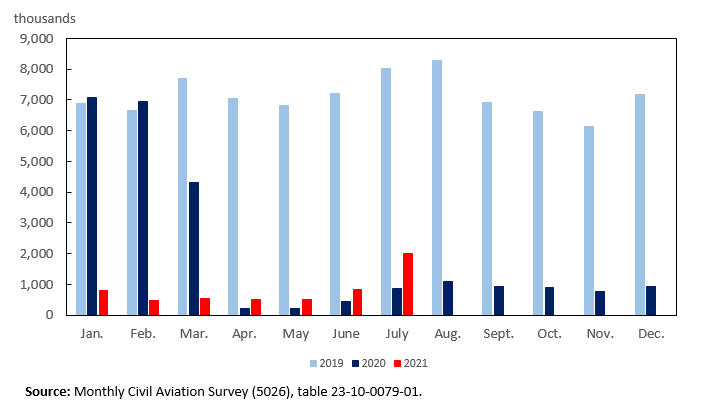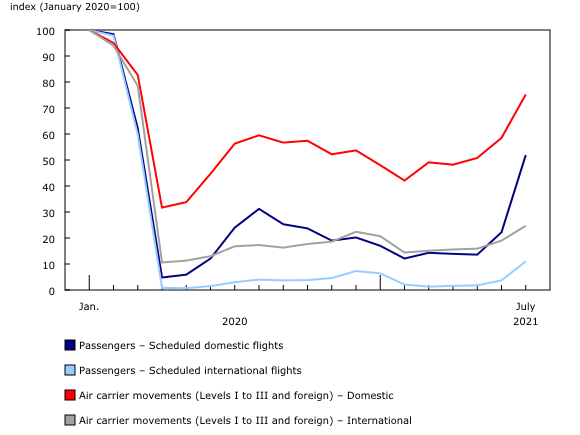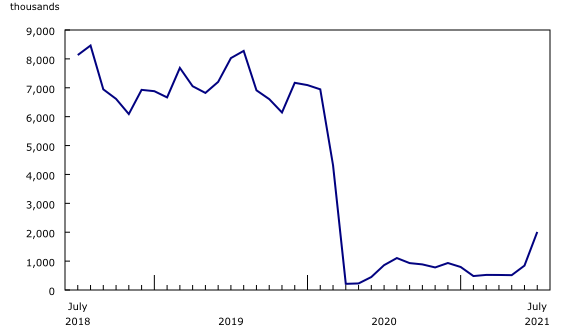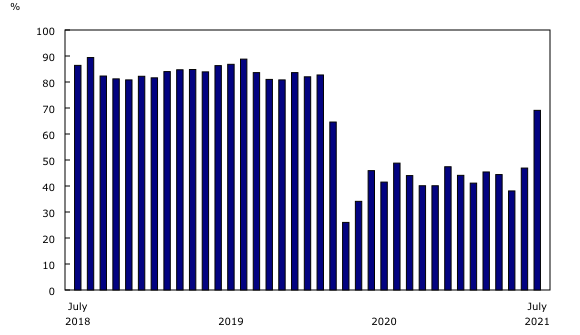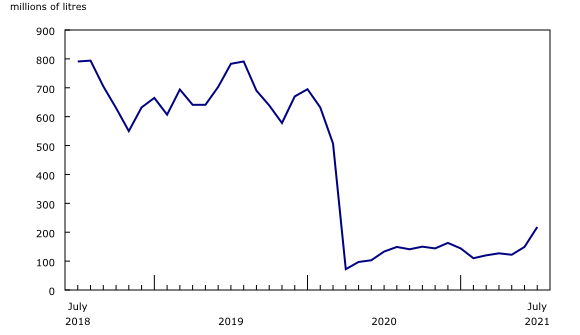Monthly civil aviation statistics, July 2021
Archived Content
Information identified as archived is provided for reference, research or recordkeeping purposes. It is not subject to the Government of Canada Web Standards and has not been altered or updated since it was archived. Please "contact us" to request a format other than those available.
Released: 2021-09-27
Highlights
Major Canadian airlines carried 2.0 million passengers on scheduled and charter services in July, the most since the pandemic began. While this was more than double the number of passengers in July 2020, it was one-quarter (25.0%) of the pre-pandemic level reported in July 2019.
The passenger load factor rose above 50% for the first time since March 2020, reaching 69.1% in July 2021.
The $503.7 million earned in operating revenue in July 2021 was roughly one-fifth (20.1%) of that earned before the pandemic in July 2019.
Border restrictions begin to ease
July brought the first easing of border restrictions. As of July 5, mandatory testing upon arrival in Canada with a hotel stopover as part of a 14-day quarantine—which had been in force since February—was no longer required of fully vaccinated Canadians and permanent residents.
The leading indicator of international arrivals to Canada, July 2021, showed an increase in the number of Canadians returning to Canada by air as of July 6. Similarly, data from the Canada Border Services Agency showed that the number of commercial air travellers to Canada more than doubled in the week of July 5 compared with the previous week.
Domestic travel in July was supported by further relaxation of provincial restrictions on gatherings, activities and interprovincial travel.
On March 11, 2020, COVID-19 was declared a pandemic by the World Health Organization. In the months that followed, Canadian air travel remained well below historical levels. Unless otherwise specified, comparisons are made with the same month in 2019 (also referred to as "pre-pandemic"), when airline activity levels were in line with historical trends.
Air travel picks up in July
Canadian Level I air carriers flew 2.0 million passengers on scheduled and charter services in July, the highest number since March 2020. For the first time since the beginning of the pandemic, the number of passengers reached 2 million. Nevertheless, this was down 75.0% from the pre-pandemic level of July 2019, although it was a notable improvement over the 88.3% decline in June (from June 2019, before the pandemic).
On a monthly basis, the number of passengers flown in July more than doubled from June, with increases on both domestic and international routes. On transborder flights between Canada and the United States in particular, passenger numbers almost quadrupled from June to July. This increase coincided with the discernible uptick in weekly transborder aircraft movements reported for July.
At 4.2 billion passenger-kilometres, traffic in July was 81.5% below the pre-pandemic level posted in July 2019. Capacity was 6.1 billion available seat-kilometres, down 76.7% from two years earlier.
Compared with the previous month, traffic in July increased relatively more than capacity. As a result, the passenger load factor (the ratio of passenger-kilometres to available seat-kilometres) increased to 69.1%, the highest level since February 2020. This followed 15 consecutive months—April 2020 through June 2021—when the load factor remained below 50%. Despite this improvement, the load factor in July 2021 was still significantly lower than the 86.8% reached in July 2019.
Other measures rise but remain low
Each passenger travelled an average of 2,102 kilometres in July. While this average distance was higher than that in the previous four months, it was 25.9% lower than that in July 2019.
At 54,000, the number of flying hours in July was 74.2% below the pre-pandemic level posted in July 2019.
Operating revenue earned by Level I carriers totalled $503.7 million in July, down 79.9% from the $2.5 billion reported in July 2019.
Note to readers
The Monthly Civil Aviation Survey covers all Canadian Level I air carriers: Air Canada (including Air Canada Rouge), Air Transat, Jazz, Porter, Sunwing and WestJet (including Swoop, WestJet Encore and WestJet Link).
The average passenger trip length is calculated by dividing the number of passenger-kilometres by the number of passengers. Trips across Canada and around the world are included in this calculation.
The data in this monthly release are not seasonally adjusted.
Contact information
For more information, or to enquire about the concepts, methods or data quality of this release, contact us (toll-free 1-800-263-1136; 514-283-8300; STATCAN.infostats-infostats.STATCAN@canada.ca) or Media Relations (613-951-4636; STATCAN.mediahotline-ligneinfomedias.STATCAN@canada.ca).
- Date modified:



